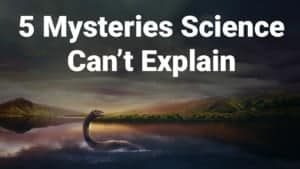Why do we humans love a good mystery? Is it the excitement of the unknown? Maybe it’s the interest in something bigger than ourselves. We yearn to solve a puzzling enigma that far surpasses our everyday lives of responsibilities and work, which can be taxing and stressful.
Well, say no more. Let’s try to unravel these historic mysteries…
Here are ten of the biggest mysteries in history:

#1. Is there life after death?
Let’s start by going deep… what happens after our hearts stop beating?
This question has probably been asked since the dawn of mankind: is this life all that there is?
While we may never be able to prove that something happens when we die, there’s loads of anecdotal – and some say, scientific – evidence to support the theory.
The story of Pam Reynolds is one of the more convincing cases. Reynolds, 35 years old at the time, underwent a ‘standstill operation’ to remove an enlarged brain aneurysm. For the operation to be possible, her neurosurgeon, Dr. Robert Spetzler, induced her into clinical death.
Despite being clinically dead, Reynolds states that she had a near-death experience and accurately recalled all of the events that transpired during the operation. Spetzler confirmed that Reynold’s observations were correct and that he had no explanation for them.
#2. Is ESP real?
ESP, or extrasensory perception, is the perception of information sensed by the mind instead of the physical senses. Examples of ESP include clairvoyance, telepathy, and psychokinesis.
In the era of modern science and astounding technological accomplishments, many view ESP with a heavy dose of skepticism. At least in the West.
If you were to travel East and ask this question to Zen masters, sadhus, or yogis, you’d probably be amazed. Not only do they think of these “powers” as real, but they also consider them commonplace.
Here’s Dean Radin, Ph.D., and author of the book “Supernormal: Science, Yoga, and the Evidence For Extraordinary Psychic Abilities”:
“…advanced [meditative] capacities are not regarded as magical; they’re ordinary capacities that everyone possesses. We’re just too distracted most of the time to be able to access them reliably.” (Source)
The fact that most people have had at least a glimpse of an ESP experience fuels the fascination. After all, what is this phenomenon we call intuition?
#3. Who was the ‘Real Jesus’?
Jesus of Nazareth, who some call Christ, is undoubtedly the most influential (and perhaps controversial) figure to have ever lived. He remains somewhat of a mystery in many, including some Christian practitioners.
Most of the information about Jesus comes from the four synoptic gospels – the books of Matthew, Mark, Luke, and John of the New Testament.
Outside of these literary works, few details about the life of Jesus exist. There are no particulars concerning Jesus’ appearance – and very few of his personality or disposition.
Then there’s the omission of details regarding 17 years of Jesus’ life. The gospels share nothing from ages 13 to 30 when Jesus began his ministry. And again, there are no accounts of what Jesus did during these 17 years outside of the New Testament.
There is some speculation – and some say, substantial evidence – that Jesus traveled Eastward to India and perhaps beyond. While such details are beyond the scope of this article, BBC ran a documentary titled “Jesus was a Buddhist Monk.” Followers of the Vedic religions say that Jesus studied yoga.
In other words, this may remain one of humankind’s greatest mysteries. Indeed, we may never know who the ‘Real Jesus’ was.
#4. Is there extraterrestrial life?
Contrary to the insistence of some, the fascination with UFOs and ETs aren’t byproduct of an acid-fueled 60s. UFOs and ETs – and even some ‘visitations’ – date back thousands of years.
In 1897, thousands of people across the U.S. reported seeing massive airships (Edison didn’t believe it though.) Even the most “buttoned-up” claimed to see strange things. In 1904, Frank Schofield, who would become the Navy’s Commander-in-Chief of the Pacific, reported seeing “three bright red [objects]” with the largest being the “size of six suns.”
In other words, these mysteries have been going on for a long time.
#5. Did ‘Atlantis’ exist?
In the fourth century B.C., the Greek philosopher Plato insisted that a lost land named Atlantis existed somewhere in the Atlantic Ocean. Plato said that the inhabitants of Atlantis conquered large swaths of Asia and Europe in prehistoric times.
While most scholars generally agree that Atlantis does not exist, Plato’s tale of Atlantis’ conquests coincided with the later discovery of the Minoan civilization. The Minoans discovered and built technologies far ahead of the time, including massive building complexes, tools, written language, and even trade networks.
A civilization with such advanced knowledge for their time (c. 2700 to c. 1450 BCE) could – at least hypothetically – conquer whoever they wanted.
#6. What is dark matter?
Science defines ‘Dark matter’ as about 85 percent of the known Universe. Dark matter causes ‘gravity,’ forms galactic clusters, and enables all celestial motion.
Yet nobody knows what it is.
Some scientists posit that it consists of yet-to-be-discovered subatomic particles. This hypothesis is certainly not out of the question, considering that the foundation of quantum mechanics (i.e., quantum physics) came about less than a century ago. Thus, the technology to measure certain quantum phenomena is in its infancy.
#7. What happened to Jimmy Hoffa?
James (Jimmy) Hoffa was a trade unionist and union leader who was the President of the International Brotherhood of Teamsters (IBT) from 1957 to 1971. Eventually, Hoffa became the most powerful union leader in United States history. Indeed, he grew the IBT to 2.3 million members at one point in his tenure.
Hoffa rose to power through his successful efforts to expand the Teamster’s influence across the U.S. Midwest. These efforts were much appreciated, as Hoffa became president of a truck driver union, Local 299, in 1946 – despite never actually working as a driver.
At the IBT convention of 1952, Hoffa was elected as IBT’s vice-president. In 1955, IBT headquarters relocated to Washington, D.C., a move that undoubtedly contributed to Hoffa’s national prominence and popularity.
In 1966, Hoffa’s efforts to expand the union were evident by the ratification of the National Master Freight Agreement, considered to be perhaps the most significant single accomplishment in the history of labor union activism.
But it was Hoffa’s other activities that garnered attention. Hoffa was first targeted for criminal prosecution at the McClellan Senate hearings of 1957. (Led by none other than JFK’s brother, Robert F. Kennedy). However, Hoffa would dodge these – and many subsequent other – attempts at prosecution.
Hoffa allegedly became involved with organized crime and disappeared on July 30, 1975. No remains have ever been discovered.
#8. Who was Jack the Ripper?
In the autumn of 1888, at least five women met their death by murder on the East End of London, England. Four of these women were grotesquely mutilated by a sadistic serial killer who would be coined Jack the Ripper.
All five victims of the Ripper worked as prostitutes in one of the poorest slums in London’s east end. By most accounts, crimes against prostitutes weren’t particularly noteworthy. According to Paul Begg, one of the most respected historians on Jack the Ripper and Victorian London:
“… the murder of a down-and-out Whitechapel [a poor London district] prostitute would not have aroused any public interest.”
So, why did it? Well, there was the sheer brutality and utter precision of the killings. Per Begg,
“The Ripper’s crimes were extraordinarily brutal and marked by extreme and increasing mutilation…” and that “…he killed at the right place at the right time.”
But the Ripper murders were not just about an insane, ruthless serial killer who lured innocent women to their death.
Underneath all of the hysteria, fear, and, yes, intrigue, were the social ills of gender inequality, sexual objectification, and class warfare — stains on the global populace that remain to present-day.
In the 1880s, the middle class in London (and elsewhere) were “alarmed by social problems such as prostitution, vice, and crime…” according to Begg. Concerns about such crime and social ills may have contributed to the massive law enforcement effort to capture the killer.
Despite the social panic, authorities never caught Jack the Ripper. Detectives and other experts have linked him to as many as 17 murders.
#9. What happened to Flight 370?
Malaysia Airlines Flight 270 took off from Kuala Lumpur en route to Beijing on March 8, 2014. Thirty-eight minutes into the flight, air traffic control lost communication with the crew. Just minutes after that, the plane disappeared from the ATC radar altogether.
A three-year search yielded no aircraft found. Tragically, 239 occupants (227 passengers and 12 crew members) perished, presumably.
#10. Is there treasure on Oak Island?
Some people will do just about anything for money. The “lost treasure” of Oak Island is a fitting example of the insatiable human greed complex. It’s also a pretty fascinating story.
Oak Island is (you guessed it) an island in Nova Scotia. The original story goes that a seafaring lad named Captain Kidd (1645-1701), whose dying minion claimed that the good Captain buried about two million pounds of treasure on the island. The first industrial-scale digging efforts commenced around the year 1799.
What were some of these supposed treasures? Meh, nothing much. The original manuscripts of William Shakespeare, the Holy Grail, the Ark of the Covenant, and a bit of pirate treasure.
Explorers and treasure hunters fail to find the cache despite numerous people’s (sometimes deadly) efforts. To date, six men have perished looking for the evasive treasure trove.
Final Thoughts: Will These Mysteries Ever Be Solved?
So will anyone ever unravel these mysteries? Let us know in the comments. While some are under active, ongoing investigations, others are ancient history. Only time will tell.


















